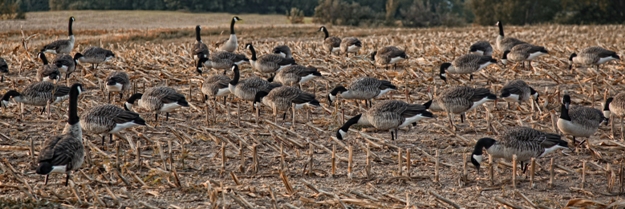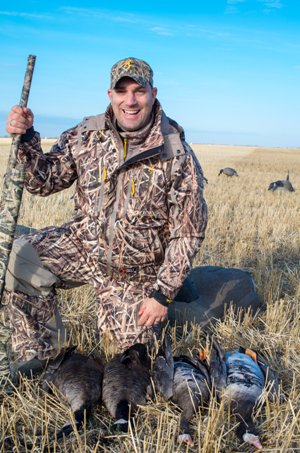
Editor’s Note: Mario Friendy of Sherwood, Oregon, is in charge of all western sales and the Zink Calls Pro Staff in Canada and is the Mossy Oak Pro Staff Regional Manager for waterfowl for the Pacific flyway. Since he was 8-years old, Friendy's been hunting ducks and geese - first with his dad in Pennsylvania where he grew up - and he’s won the Best of the West two-man duck calling championship.
In our zone, we have seven different species of Canada geese - Vancouver, Western, Lesser Canada Goose, Greater White-Fronted goose, Taverner, Dusky and Cackling. That’s the good news. But all these geese are the same color. The geese vary in size, bill length and chest color. The bad news is that you cannot shoot the Dusky Canada goose, since it’s protected in Oregon. The Dusky is darker chested than the other geese, and its wings are a somewhat wider than the other Canada geese. Before you goose hunt in Oregon, you have to take an identification test to hunt geese in the permit zone. You can take four geese per day. Our dominant Canada geese are Lessers, Cacklers and Taverners. You have to be able to identify your geese in the air to make sure you don’t shoot a Dusky. If you mistakenly shoot a Dusky Canada goose, you don’t get ticketed, but your goose hunting is over for the season, and you have to retake the goose identification test. Also, when you shoot a goose in the permit zone, you have to fill out a harvest card immediately. You have to write down on the card the number of geese you’ve shot. When you complete your limit of four geese, you have to take them to a check-in station to make sure you haven’t harvested a dusky Canada goose. At the check-in stations, the wildlife officials get a lot of data from the harvest records.
 The permit zone is on the western side of I-5 in western Oregon. East of I-5 isn’t involved. Because my friends and I are closest to the permit zone, this is where we hunt Canada geese. My house is actually in the permit zone. Being able to identify the subspecies of Canada goose while it’s in the air before you take the shot requires some skill and practice. However, the more you hunt these geese, the easier it is to identify them. On low light days, rainy days or snow days, we have to let the geese get in really close, so we can identify them before we take the shot. I strongly recommend that anyone coming to Oregon who’s going to hunt in the permit zone go with a local or a guide who can identify the geese for you before you take the shot. Click here to see all different kinds of Canada geese and how to identify them.
The permit zone is on the western side of I-5 in western Oregon. East of I-5 isn’t involved. Because my friends and I are closest to the permit zone, this is where we hunt Canada geese. My house is actually in the permit zone. Being able to identify the subspecies of Canada goose while it’s in the air before you take the shot requires some skill and practice. However, the more you hunt these geese, the easier it is to identify them. On low light days, rainy days or snow days, we have to let the geese get in really close, so we can identify them before we take the shot. I strongly recommend that anyone coming to Oregon who’s going to hunt in the permit zone go with a local or a guide who can identify the geese for you before you take the shot. Click here to see all different kinds of Canada geese and how to identify them.
In Oregon, our goose season is about 90 days. We have three different seasons. The first season starts at the end of October and goes into the first of November. The second season starts in November and goes to the end of January. Then, the third season is the entire month of February. The section of Oregon where I live is the grass seed capital of the world. The geese feed on green grass and clover throughout the entire season. You may not think that geese eating grass is bad, unless, you understand that grass is a cash crop for many of the farmers here in Oregon. That’s why the farmers here really appreciate goose hunters harvesting the geese that are eating their grass.
We usually put out five or six dozen full body decoys. In the permit zone where we hunt, these geese get a pretty good bit of hunting pressure. If you want to be successful, having quality decoys is a really big deal. So, we use the Avian-X (https://www.avian-x.com/) Flocked full body Canada geese decoys. I use the fully flocked geese - the whole body of the decoy is flocked. We use lots of feeding decoys in our spread. We either use layout blinds or A-frame blinds on the fence rows. It’s not unusual for us to have 150 geese coming in at one time. Sometimes, we’ll have 200 or more in the flocks. Our most dominant goose is the Cacklers, which act a lot like snow geese. They come in big groups, and they're very noisy. We need a large spread for them, and we really have to hide well. I use a 12 gauge Browning Maxus for the geese, and I use Hevi-Metal shotgun shells made by Hevi-Shot. I also shoot BBs at the geese.
Day 3: Western River Duck Hunting
Tomorrow: Mario Friendy: Snows to the South




























